2007 ISUZU KB P190 sensor
[x] Cancel search: sensorPage 3476 of 6020
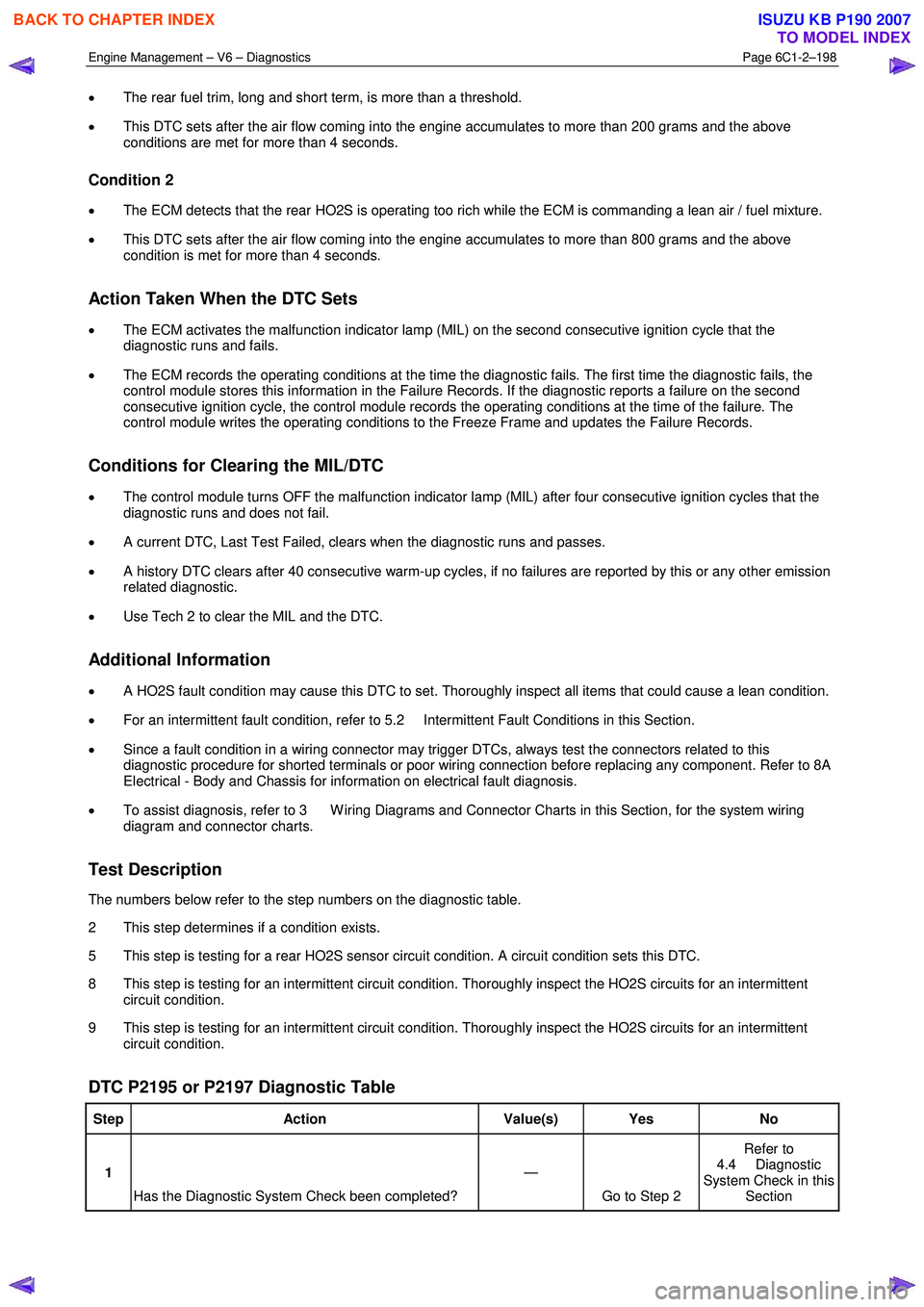
Engine Management – V6 – Diagnostics Page 6C1-2–198
• The rear fuel trim, long and short term, is more than a threshold.
• This DTC sets after the air flow coming into the engine accumulates to more than 200 grams and the above
conditions are met for more than 4 seconds.
Condition 2
• The ECM detects that the rear HO2S is operating too rich while the ECM is commanding a lean air / fuel mixture.
• This DTC sets after the air flow coming into the engine accumulates to more than 800 grams and the above
condition is met for more than 4 seconds.
Action Taken When the DTC Sets
• The ECM activates the malfunction indicator lamp (MIL) on the second consecutive ignition cycle that the
diagnostic runs and fails.
• The ECM records the operating conditions at the time the diagnostic fails. The first time the diagnostic fails, the
control module stores this information in the Failure Records. If the diagnostic reports a failure on the second
consecutive ignition cycle, the control module records the operating conditions at the time of the failure. The
control module writes the operating conditions to the Freeze Frame and updates the Failure Records.
Conditions for Clearing the MIL/DTC
• The control module turns OFF the malfunction indicator lamp (MIL) after four consecutive ignition cycles that the
diagnostic runs and does not fail.
• A current DTC, Last Test Failed, clears when the diagnostic runs and passes.
• A history DTC clears after 40 consecutive warm-up cycles, if no failures are reported by this or any other emission
related diagnostic.
• Use Tech 2 to clear the MIL and the DTC.
Additional Information
• A HO2S fault condition may cause this DTC to set. Thoroughly inspect all items that could cause a lean condition.
• For an intermittent fault condition, refer to 5.2 Intermittent Fault Conditions in this Section.
• Since a fault condition in a wiring connector may trigger DTCs, always test the connectors related to this
diagnostic procedure for shorted terminals or poor wiring connection before replacing any component. Refer to 8A
Electrical - Body and Chassis for information on electrical fault diagnosis.
• To assist diagnosis, refer to 3 W iring Diagrams and Connector Charts in this Section, for the system wiring
diagram and connector charts.
Test Description
The numbers below refer to the step numbers on the diagnostic table.
2 This step determines if a condition exists.
5 This step is testing for a rear HO2S sensor circuit condition. A circuit condition sets this DTC.
8 This step is testing for an intermittent circuit condition. Thoroughly inspect the HO2S circuits for an intermittent circuit condition.
9 This step is testing for an intermittent circuit condition. Thoroughly inspect the HO2S circuits for an intermittent circuit condition.
DTC P2195 or P2197 Diagnostic Table
Step Action Value(s) Yes No
1
Has the Diagnostic System Check been completed? —
Go to Step 2 Refer to
4.4 Diagnostic
System Check in this Section
BACK TO CHAPTER INDEX
TO MODEL INDEX
ISUZU KB P190 2007
Page 3477 of 6020
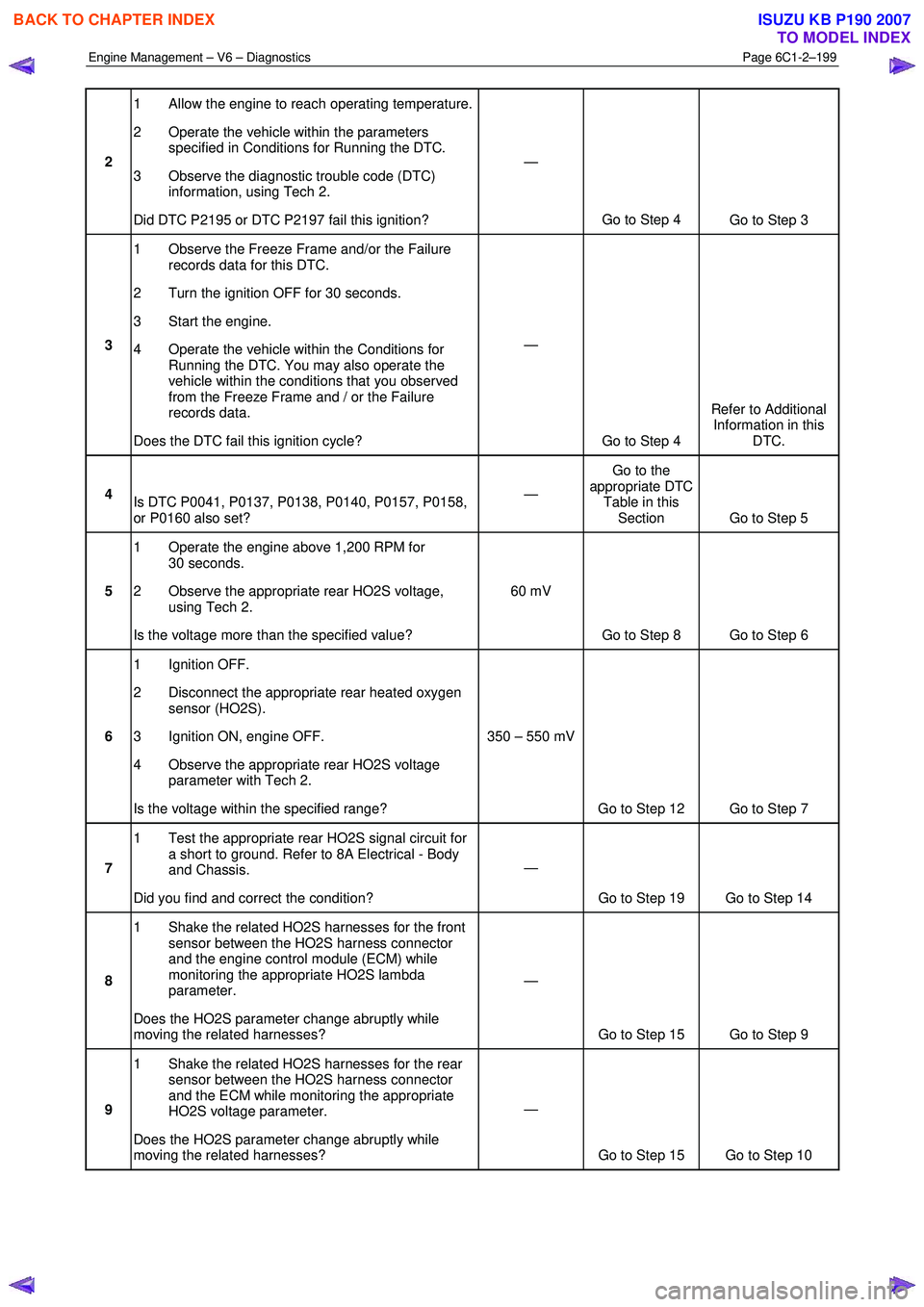
Engine Management – V6 – Diagnostics Page 6C1-2–199
2 1 Allow the engine to reach operating temperature.
2 Operate the vehicle within the parameters specified in Conditions for Running the DTC.
3 Observe the diagnostic trouble code (DTC) information, using Tech 2.
Did DTC P2195 or DTC P2197 fail this ignition? —
Go to Step 4 Go to Step 3
3 1 Observe the Freeze Frame and/or the Failure
records data for this DTC.
2 Turn the ignition OFF for 30 seconds.
3 Start the engine.
4 Operate the vehicle within the Conditions for Running the DTC. You may also operate the
vehicle within the conditions that you observed
from the Freeze Frame and / or the Failure
records data.
Does the DTC fail this ignition cycle? —
Go to Step 4 Refer to Additional
Information in this DTC.
4 Is DTC P0041, P0137, P0138, P0140, P0157, P0158,
or P0160 also set? —
Go to the
appropriate DTC Table in this Section Go to Step 5
5 1 Operate the engine above 1,200 RPM for
30 seconds.
2 Observe the appropriate rear HO2S voltage, using Tech 2.
Is the voltage more than the specified value? 60 mV
Go to Step 8 Go to Step 6
6 1 Ignition OFF.
2 Disconnect the appropriate rear heated oxygen sensor (HO2S).
3 Ignition ON, engine OFF.
4 Observe the appropriate rear HO2S voltage parameter with Tech 2.
Is the voltage within the specified range? 350 – 550 mV
Go to Step 12 Go to Step 7
7 1 Test the appropriate rear HO2S signal circuit for
a short to ground. Refer to 8A Electrical - Body
and Chassis.
Did you find and correct the condition? —
Go to Step 19 Go to Step 14
8 1 Shake the related HO2S harnesses for the front
sensor between the HO2S harness connector
and the engine control module (ECM) while
monitoring the appropriate HO2S lambda
parameter.
Does the HO2S parameter change abruptly while
moving the related harnesses? —
Go to Step 15 Go to Step 9
9 1 Shake the related HO2S harnesses for the rear
sensor between the HO2S harness connector
and the ECM while monitoring the appropriate
HO2S voltage parameter.
Does the HO2S parameter change abruptly while
moving the related harnesses? —
Go to Step 15 Go to Step 10
BACK TO CHAPTER INDEX
TO MODEL INDEX
ISUZU KB P190 2007
Page 3478 of 6020
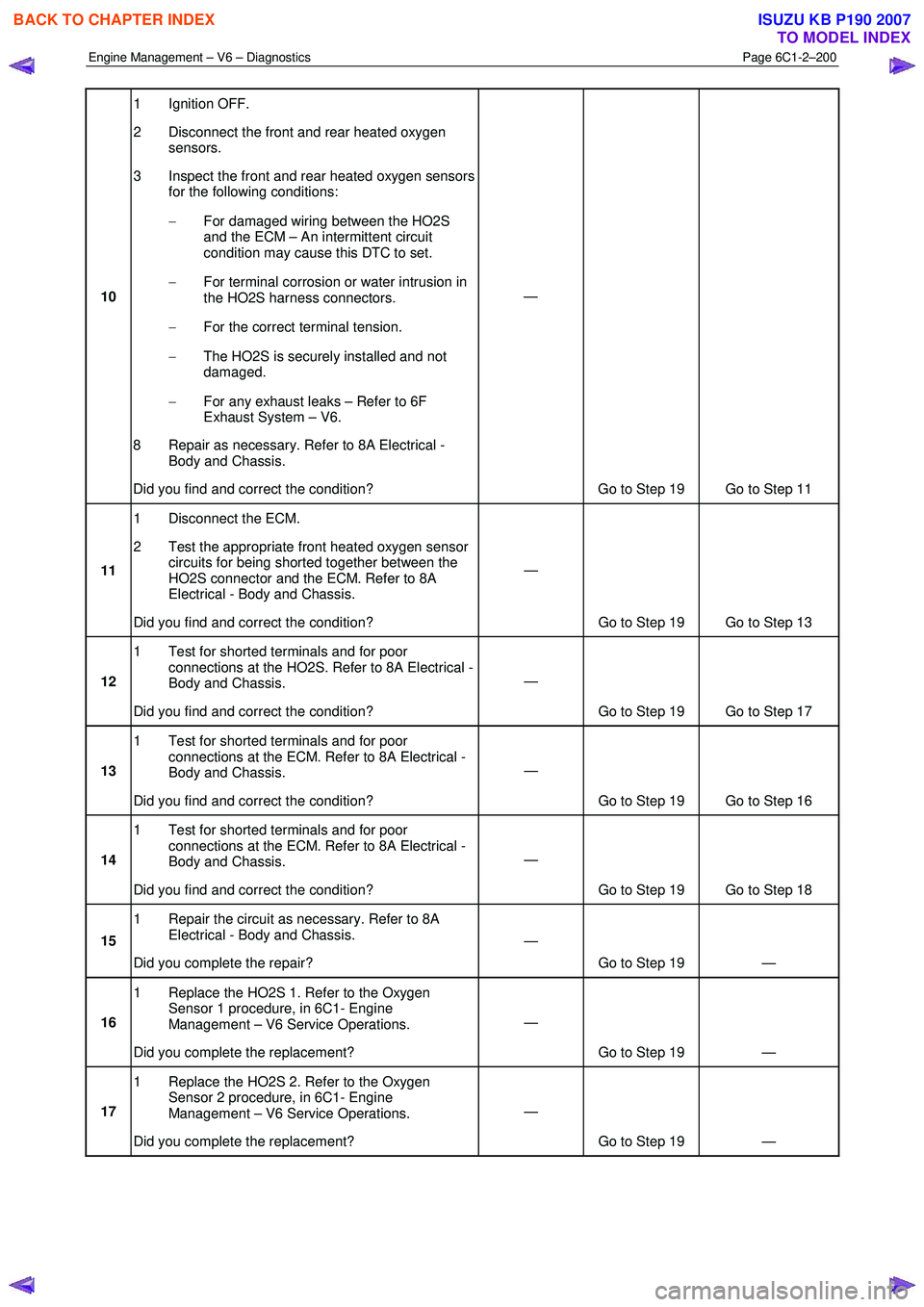
Engine Management – V6 – Diagnostics Page 6C1-2–200
10 1 Ignition OFF.
2 Disconnect the front and rear heated oxygen sensors.
3 Inspect the front and rear heated oxygen sensors for the following conditions:
− For damaged wiring between the HO2S
and the ECM – An intermittent circuit
condition may cause this DTC to set.
− For terminal corrosion or water intrusion in
the HO2S harness connectors.
− For the correct terminal tension.
− The HO2S is securely installed and not
damaged.
− For any exhaust leaks – Refer to 6F
Exhaust System – V6.
8 Repair as necessary. Refer to 8A Electrical - Body and Chassis.
Did you find and correct the condition? —
Go to Step 19 Go to Step 11
11 1 Disconnect the ECM.
2 Test the appropriate front heated oxygen sensor circuits for being shorted together between the
HO2S connector and the ECM. Refer to 8A
Electrical - Body and Chassis.
Did you find and correct the condition? —
Go to Step 19 Go to Step 13
12 1 Test for shorted terminals and for poor
connections at the HO2S. Refer to 8A Electrical -
Body and Chassis.
Did you find and correct the condition? —
Go to Step 19 Go to Step 17
13 1 Test for shorted terminals and for poor
connections at the ECM. Refer to 8A Electrical -
Body and Chassis.
Did you find and correct the condition? —
Go to Step 19 Go to Step 16
14 1 Test for shorted terminals and for poor
connections at the ECM. Refer to 8A Electrical -
Body and Chassis.
Did you find and correct the condition? —
Go to Step 19 Go to Step 18
15 1 Repair the circuit as necessary. Refer to 8A
Electrical - Body and Chassis.
Did you complete the repair? —
Go to Step 19 —
16 1 Replace the HO2S 1. Refer to the Oxygen
Sensor 1 procedure, in 6C1- Engine
Management – V6 Service Operations.
Did you complete the replacement? —
Go to Step 19 —
17 1 Replace the HO2S 2. Refer to the Oxygen
Sensor 2 procedure, in 6C1- Engine
Management – V6 Service Operations.
Did you complete the replacement? —
Go to Step 19 —
BACK TO CHAPTER INDEX
TO MODEL INDEX
ISUZU KB P190 2007
Page 3479 of 6020
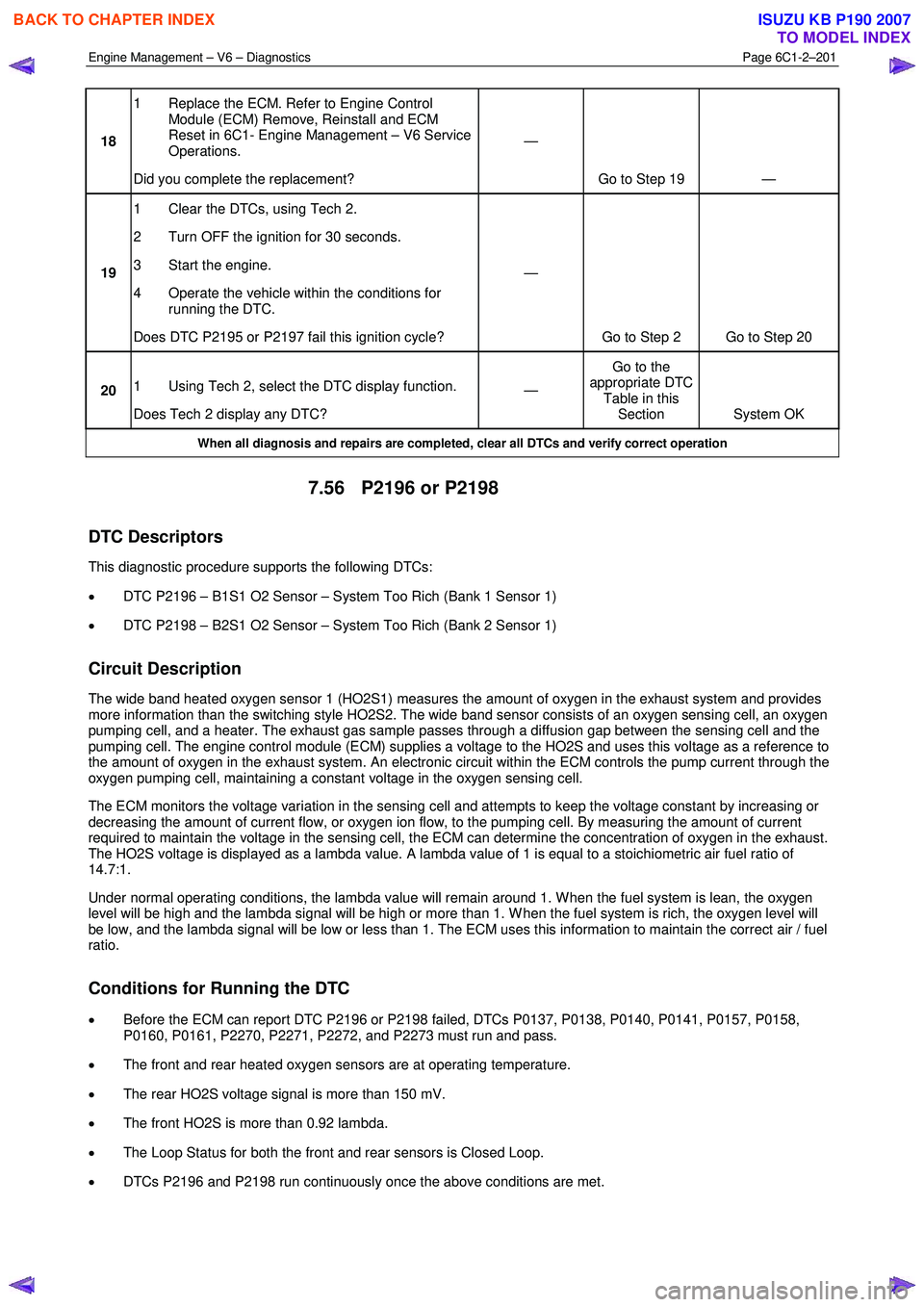
Engine Management – V6 – Diagnostics Page 6C1-2–201
18 1 Replace the ECM. Refer to Engine Control
Module (ECM) Remove, Reinstall and ECM
Reset in 6C1- Engine Management – V6 Service
Operations.
Did you complete the replacement? —
Go to Step 19 —
19 1 Clear the DTCs, using Tech 2.
2 Turn OFF the ignition for 30 seconds.
3 Start the engine.
4 Operate the vehicle within the conditions for running the DTC.
Does DTC P2195 or P2197 fail this ignition cycle? —
Go to Step 2 Go to Step 20
20 1 Using Tech 2, select the DTC display function.
Does Tech 2 display any DTC? —
Go to the
appropriate DTC Table in this Section System OK
When all diagnosis and repairs are completed, clear all DTCs and verify correct operation
7.56 P2196 or P2198
DTC Descriptors
This diagnostic procedure supports the following DTCs:
• DTC P2196 – B1S1 O2 Sensor – System Too Rich (Bank 1 Sensor 1)
• DTC P2198 – B2S1 O2 Sensor – System Too Rich (Bank 2 Sensor 1)
Circuit Description
The wide band heated oxygen sensor 1 (HO2S1) measures the amount of oxygen in the exhaust system and provides
more information than the switching style HO2S2. The wide band sensor consists of an oxygen sensing cell, an oxygen
pumping cell, and a heater. The exhaust gas sample passes through a diffusion gap between the sensing cell and the
pumping cell. The engine control module (ECM) supplies a voltage to the HO2S and uses this voltage as a reference to
the amount of oxygen in the exhaust system. An electronic circuit within the ECM controls the pump current through the
oxygen pumping cell, maintaining a constant voltage in the oxygen sensing cell.
The ECM monitors the voltage variation in the sensing cell and attempts to keep the voltage constant by increasing or
decreasing the amount of current flow, or oxygen ion flow, to the pumping cell. By measuring the amount of current
required to maintain the voltage in the sensing cell, the ECM can determine the concentration of oxygen in the exhaust.
The HO2S voltage is displayed as a lambda value. A lambda value of 1 is equal to a stoichiometric air fuel ratio of
14.7:1.
Under normal operating conditions, the lambda value will remain around 1. W hen the fuel system is lean, the oxygen
level will be high and the lambda signal will be high or more than 1. W hen the fuel system is rich, the oxygen level will
be low, and the lambda signal will be low or less than 1. The ECM uses this information to maintain the correct air / fuel
ratio.
Conditions for Running the DTC
• Before the ECM can report DTC P2196 or P2198 failed, DTCs P0137, P0138, P0140, P0141, P0157, P0158,
P0160, P0161, P2270, P2271, P2272, and P2273 must run and pass.
• The front and rear heated oxygen sensors are at operating temperature.
• The rear HO2S voltage signal is more than 150 mV.
• The front HO2S is more than 0.92 lambda.
• The Loop Status for both the front and rear sensors is Closed Loop.
• DTCs P2196 and P2198 run continuously once the above conditions are met.
BACK TO CHAPTER INDEX
TO MODEL INDEX
ISUZU KB P190 2007
Page 3480 of 6020
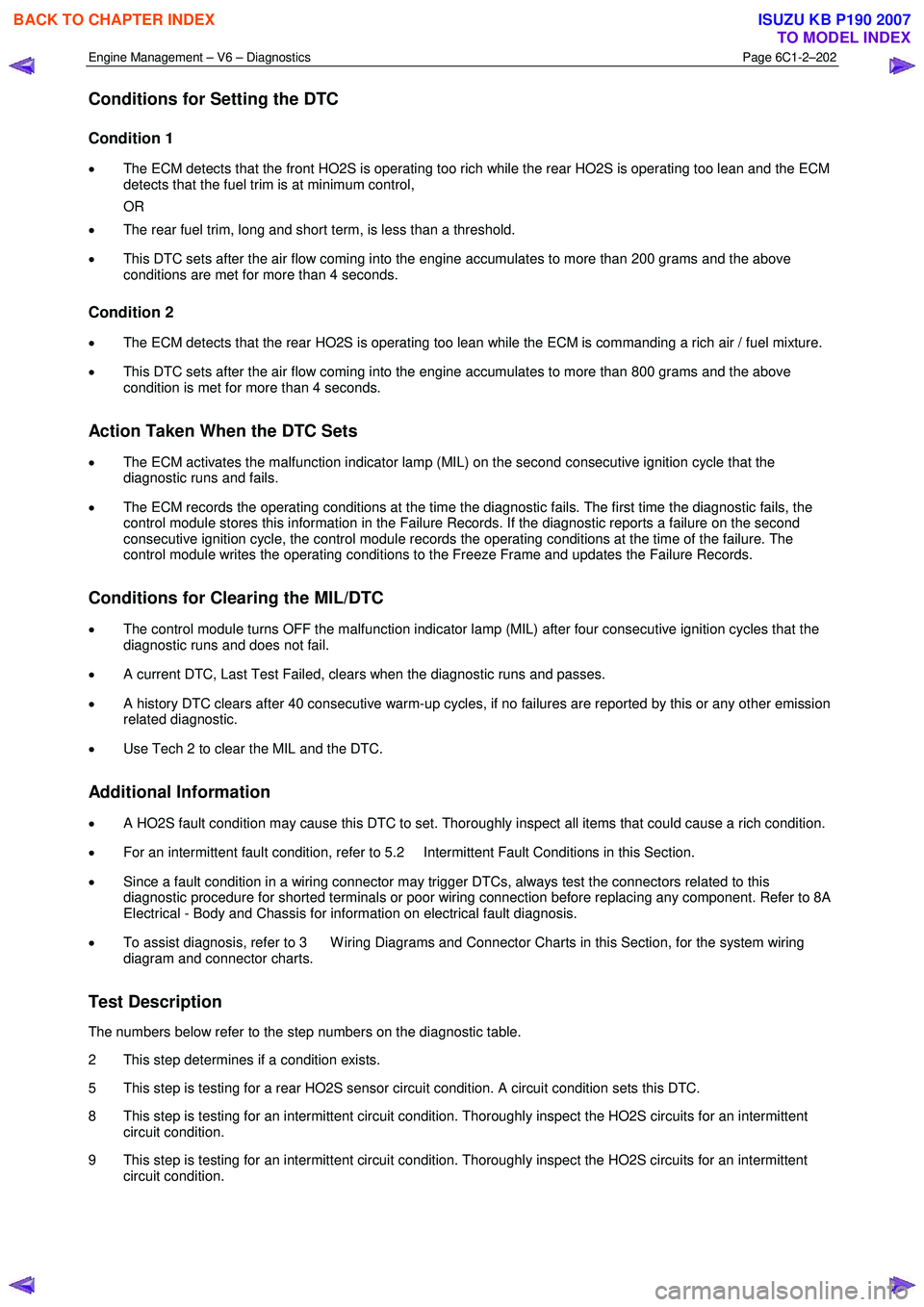
Engine Management – V6 – Diagnostics Page 6C1-2–202
Conditions for Setting the DTC
Condition 1
• The ECM detects that the front HO2S is operating too rich while the rear HO2S is operating too lean and the ECM
detects that the fuel trim is at minimum control,
OR
• The rear fuel trim, long and short term, is less than a threshold.
• This DTC sets after the air flow coming into the engine accumulates to more than 200 grams and the above
conditions are met for more than 4 seconds.
Condition 2
• The ECM detects that the rear HO2S is operating too lean while the ECM is commanding a rich air / fuel mixture.
• This DTC sets after the air flow coming into the engine accumulates to more than 800 grams and the above
condition is met for more than 4 seconds.
Action Taken When the DTC Sets
• The ECM activates the malfunction indicator lamp (MIL) on the second consecutive ignition cycle that the
diagnostic runs and fails.
• The ECM records the operating conditions at the time the diagnostic fails. The first time the diagnostic fails, the
control module stores this information in the Failure Records. If the diagnostic reports a failure on the second
consecutive ignition cycle, the control module records the operating conditions at the time of the failure. The
control module writes the operating conditions to the Freeze Frame and updates the Failure Records.
Conditions for Clearing the MIL/DTC
• The control module turns OFF the malfunction indicator lamp (MIL) after four consecutive ignition cycles that the
diagnostic runs and does not fail.
• A current DTC, Last Test Failed, clears when the diagnostic runs and passes.
• A history DTC clears after 40 consecutive warm-up cycles, if no failures are reported by this or any other emission
related diagnostic.
• Use Tech 2 to clear the MIL and the DTC.
Additional Information
• A HO2S fault condition may cause this DTC to set. Thoroughly inspect all items that could cause a rich condition.
• For an intermittent fault condition, refer to 5.2 Intermittent Fault Conditions in this Section.
• Since a fault condition in a wiring connector may trigger DTCs, always test the connectors related to this
diagnostic procedure for shorted terminals or poor wiring connection before replacing any component. Refer to 8A
Electrical - Body and Chassis for information on electrical fault diagnosis.
• To assist diagnosis, refer to 3 W iring Diagrams and Connector Charts in this Section, for the system wiring
diagram and connector charts.
Test Description
The numbers below refer to the step numbers on the diagnostic table.
2 This step determines if a condition exists.
5 This step is testing for a rear HO2S sensor circuit condition. A circuit condition sets this DTC.
8 This step is testing for an intermittent circuit condition. Thoroughly inspect the HO2S circuits for an intermittent circuit condition.
9 This step is testing for an intermittent circuit condition. Thoroughly inspect the HO2S circuits for an intermittent circuit condition.
BACK TO CHAPTER INDEX
TO MODEL INDEX
ISUZU KB P190 2007
Page 3481 of 6020
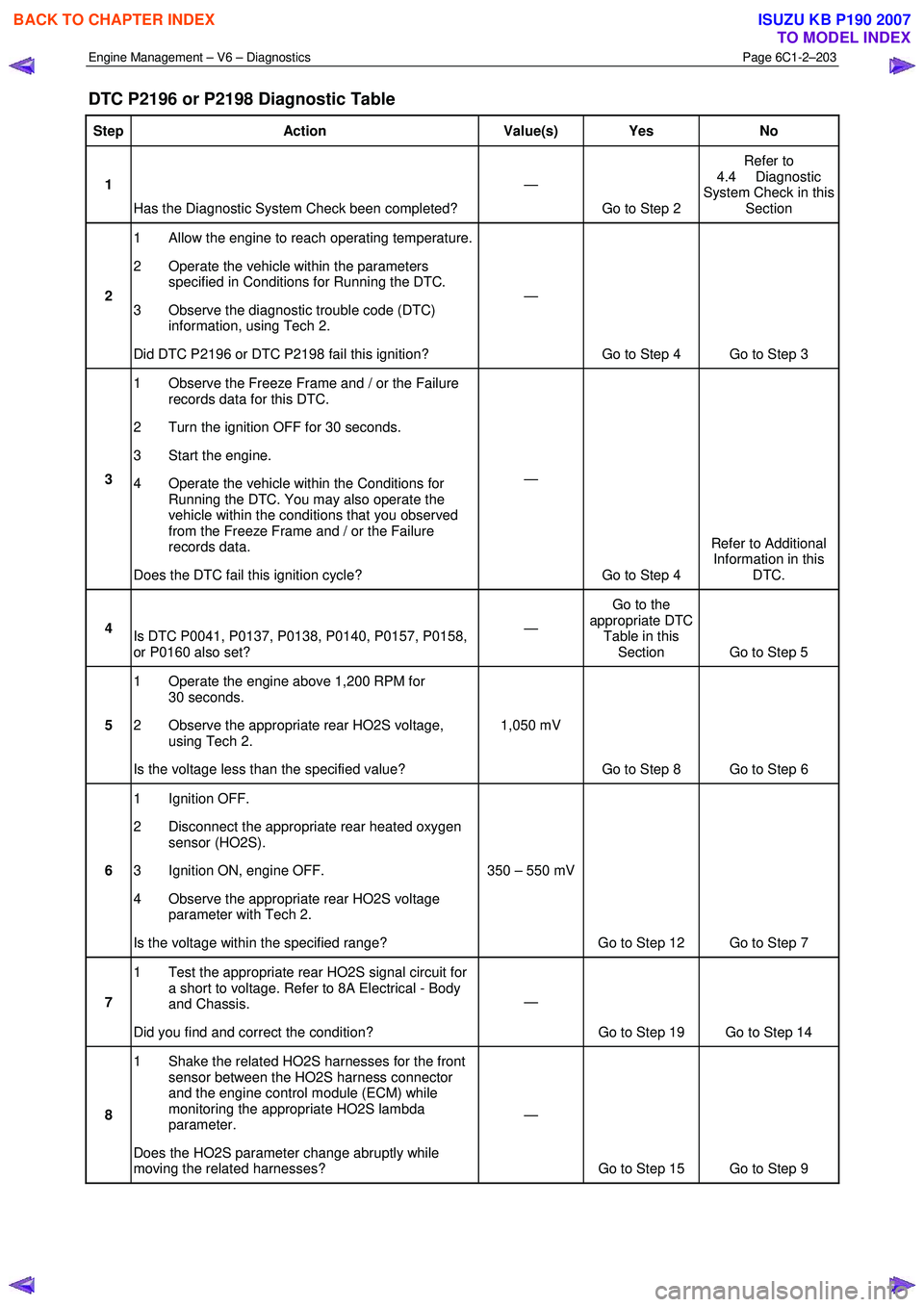
Engine Management – V6 – Diagnostics Page 6C1-2–203
DTC P2196 or P2198 Diagnostic Table
Step Action Value(s) Yes No
1
Has the Diagnostic System Check been completed? —
Go to Step 2 Refer to
4.4 Diagnostic
System Check in this Section
2 1 Allow the engine to reach operating temperature.
2 Operate the vehicle within the parameters specified in Conditions for Running the DTC.
3 Observe the diagnostic trouble code (DTC) information, using Tech 2.
Did DTC P2196 or DTC P2198 fail this ignition? —
Go to Step 4 Go to Step 3
3 1 Observe the Freeze Frame and / or the Failure
records data for this DTC.
2 Turn the ignition OFF for 30 seconds.
3 Start the engine.
4 Operate the vehicle within the Conditions for Running the DTC. You may also operate the
vehicle within the conditions that you observed
from the Freeze Frame and / or the Failure
records data.
Does the DTC fail this ignition cycle? —
Go to Step 4 Refer to Additional
Information in this DTC.
4 Is DTC P0041, P0137, P0138, P0140, P0157, P0158,
or P0160 also set? —
Go to the
appropriate DTC Table in this Section Go to Step 5
5 1 Operate the engine above 1,200 RPM for
30 seconds.
2 Observe the appropriate rear HO2S voltage, using Tech 2.
Is the voltage less than the specified value? 1,050 mV
Go to Step 8 Go to Step 6
6 1 Ignition OFF.
2 Disconnect the appropriate rear heated oxygen sensor (HO2S).
3 Ignition ON, engine OFF.
4 Observe the appropriate rear HO2S voltage parameter with Tech 2.
Is the voltage within the specified range? 350 – 550 mV
Go to Step 12 Go to Step 7
7 1 Test the appropriate rear HO2S signal circuit for
a short to voltage. Refer to 8A Electrical - Body
and Chassis.
Did you find and correct the condition? —
Go to Step 19 Go to Step 14
8 1 Shake the related HO2S harnesses for the front
sensor between the HO2S harness connector
and the engine control module (ECM) while
monitoring the appropriate HO2S lambda
parameter.
Does the HO2S parameter change abruptly while
moving the related harnesses? —
Go to Step 15 Go to Step 9
BACK TO CHAPTER INDEX
TO MODEL INDEX
ISUZU KB P190 2007
Page 3482 of 6020
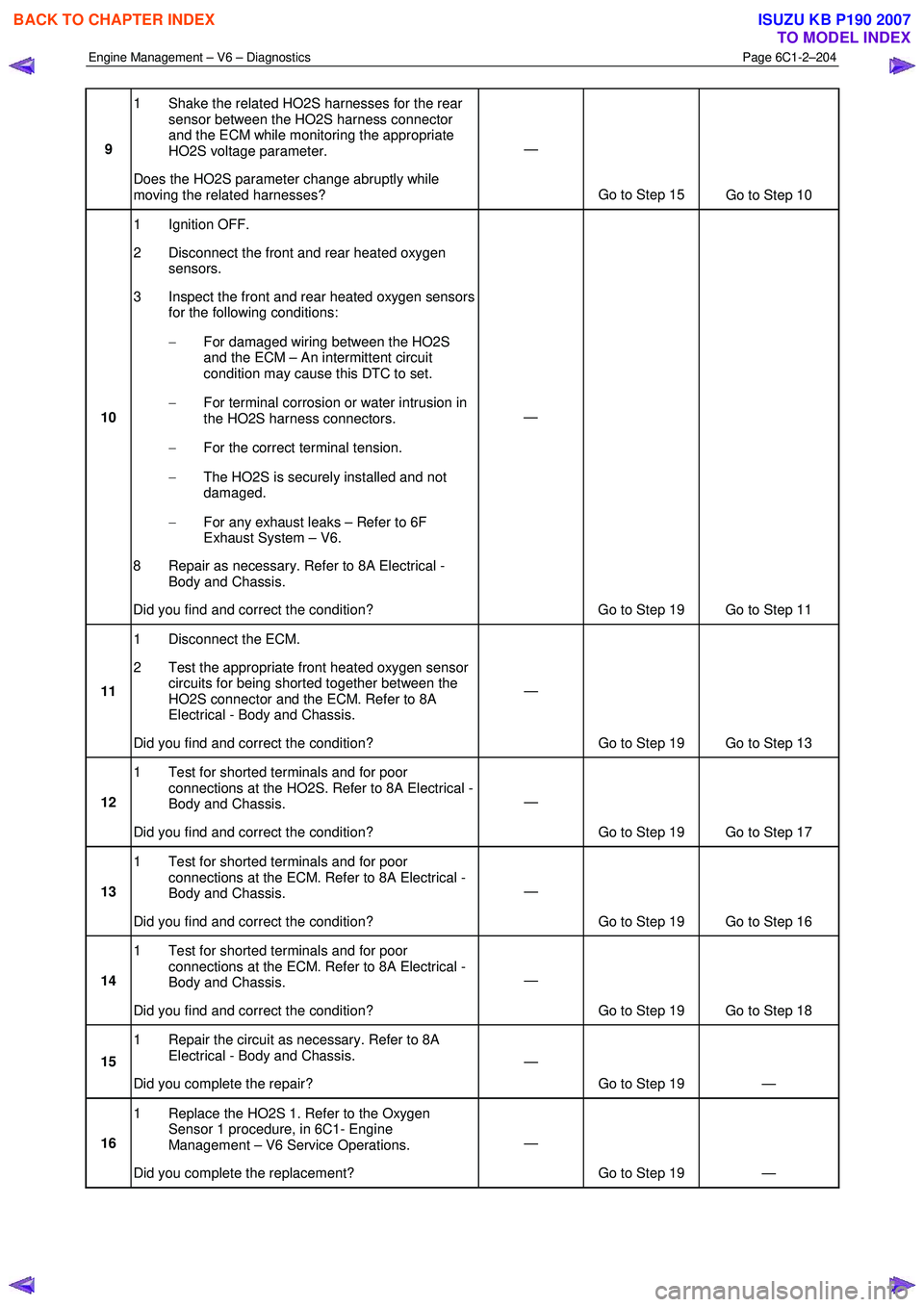
Engine Management – V6 – Diagnostics Page 6C1-2–204
9 1 Shake the related HO2S harnesses for the rear
sensor between the HO2S harness connector
and the ECM while monitoring the appropriate
HO2S voltage parameter.
Does the HO2S parameter change abruptly while
moving the related harnesses? —
Go to Step 15 Go to Step 10
10 1 Ignition OFF.
2 Disconnect the front and rear heated oxygen sensors.
3 Inspect the front and rear heated oxygen sensors for the following conditions:
− For damaged wiring between the HO2S
and the ECM – An intermittent circuit
condition may cause this DTC to set.
− For terminal corrosion or water intrusion in
the HO2S harness connectors.
− For the correct terminal tension.
− The HO2S is securely installed and not
damaged.
− For any exhaust leaks – Refer to 6F
Exhaust System – V6.
8 Repair as necessary. Refer to 8A Electrical - Body and Chassis.
Did you find and correct the condition? —
Go to Step 19 Go to Step 11
11 1 Disconnect the ECM.
2 Test the appropriate front heated oxygen sensor circuits for being shorted together between the
HO2S connector and the ECM. Refer to 8A
Electrical - Body and Chassis.
Did you find and correct the condition? —
Go to Step 19 Go to Step 13
12 1 Test for shorted terminals and for poor
connections at the HO2S. Refer to 8A Electrical -
Body and Chassis.
Did you find and correct the condition? —
Go to Step 19 Go to Step 17
13 1 Test for shorted terminals and for poor
connections at the ECM. Refer to 8A Electrical -
Body and Chassis.
Did you find and correct the condition? —
Go to Step 19 Go to Step 16
14 1 Test for shorted terminals and for poor
connections at the ECM. Refer to 8A Electrical -
Body and Chassis.
Did you find and correct the condition? —
Go to Step 19 Go to Step 18
15 1 Repair the circuit as necessary. Refer to 8A
Electrical - Body and Chassis.
Did you complete the repair? —
Go to Step 19 —
16 1 Replace the HO2S 1. Refer to the Oxygen
Sensor 1 procedure, in 6C1- Engine
Management – V6 Service Operations.
Did you complete the replacement? —
Go to Step 19 —
BACK TO CHAPTER INDEX
TO MODEL INDEX
ISUZU KB P190 2007
Page 3483 of 6020
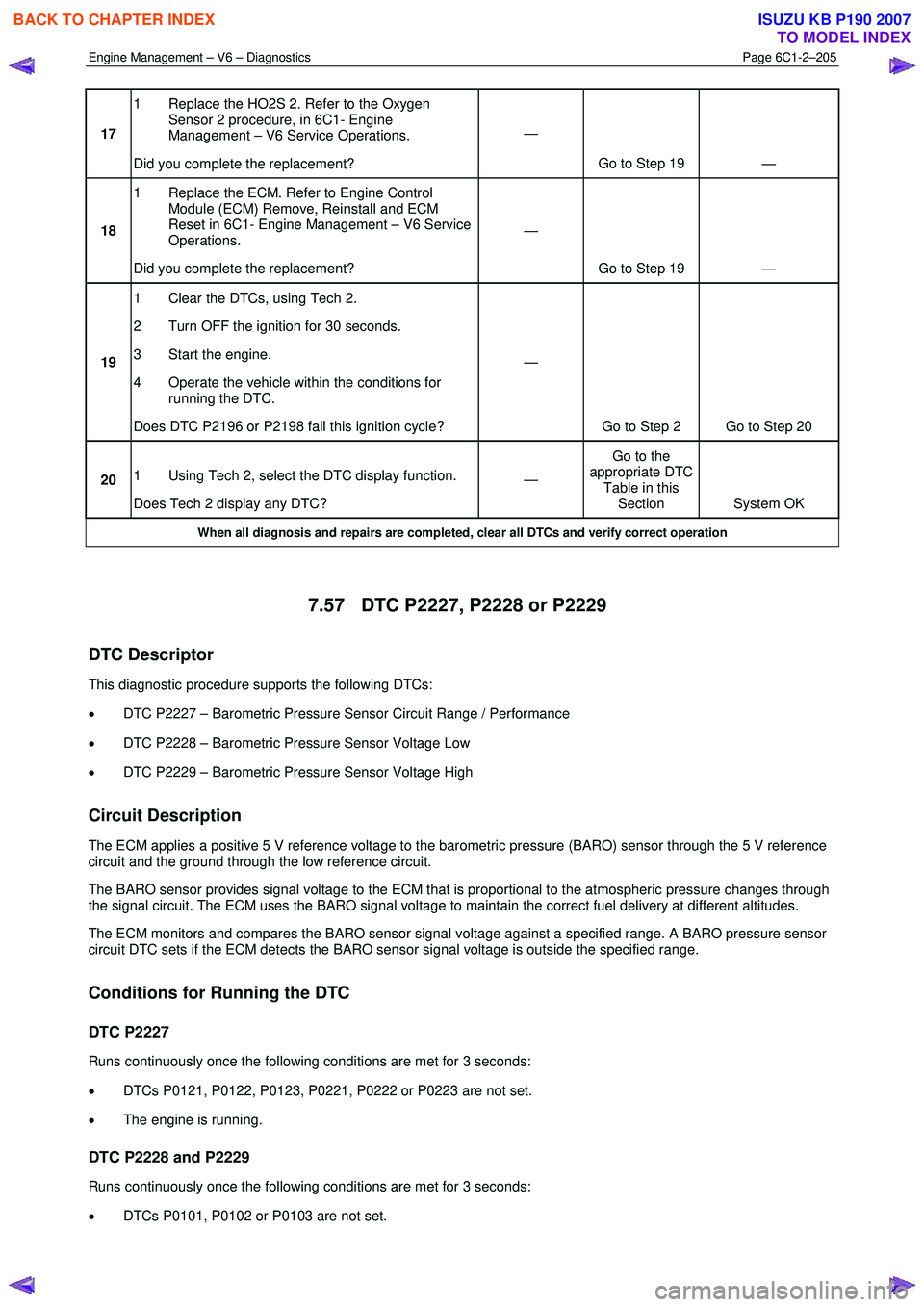
Engine Management – V6 – Diagnostics Page 6C1-2–205
17 1 Replace the HO2S 2. Refer to the Oxygen
Sensor 2 procedure, in 6C1- Engine
Management – V6 Service Operations.
Did you complete the replacement? —
Go to Step 19 —
18 1 Replace the ECM. Refer to Engine Control
Module (ECM) Remove, Reinstall and ECM
Reset in 6C1- Engine Management – V6 Service
Operations.
Did you complete the replacement? —
Go to Step 19 —
19 1 Clear the DTCs, using Tech 2.
2 Turn OFF the ignition for 30 seconds.
3 Start the engine.
4 Operate the vehicle within the conditions for running the DTC.
Does DTC P2196 or P2198 fail this ignition cycle? —
Go to Step 2 Go to Step 20
20 1 Using Tech 2, select the DTC display function.
Does Tech 2 display any DTC? —
Go to the
appropriate DTC Table in this Section System OK
When all diagnosis and repairs are completed, clear all DTCs and verify correct operation
7.57 DTC P2227, P2228 or P2229
DTC Descriptor
This diagnostic procedure supports the following DTCs:
• DTC P2227 – Barometric Pressure Sensor Circuit Range / Performance
• DTC P2228 – Barometric Pressure Sensor Voltage Low
• DTC P2229 – Barometric Pressure Sensor Voltage High
Circuit Description
The ECM applies a positive 5 V reference voltage to the barometric pressure (BARO) sensor through the 5 V reference
circuit and the ground through the low reference circuit.
The BARO sensor provides signal voltage to the ECM that is proportional to the atmospheric pressure changes through
the signal circuit. The ECM uses the BARO signal voltage to maintain the correct fuel delivery at different altitudes.
The ECM monitors and compares the BARO sensor signal voltage against a specified range. A BARO pressure sensor
circuit DTC sets if the ECM detects the BARO sensor signal voltage is outside the specified range.
Conditions for Running the DTC
DTC P2227
Runs continuously once the following conditions are met for 3 seconds:
• DTCs P0121, P0122, P0123, P0221, P0222 or P0223 are not set.
• The engine is running.
DTC P2228 and P2229
Runs continuously once the following conditions are met for 3 seconds:
• DTCs P0101, P0102 or P0103 are not set.
BACK TO CHAPTER INDEX
TO MODEL INDEX
ISUZU KB P190 2007